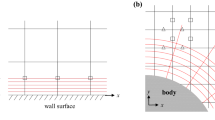Abstract
Turbulent flows are characterized by the presence of "scales of fluctuations", or "structures" of varying magnitudes, the effects in which the mixing, transfer and dissipation of energy are preponderant. Most importantly, dissipation determines the depth profile of the flow. This contribution aims to implement a model able to predict unsteady turbulent flows generated by the presence of obstacles in a channel with complex geometry and to report, where the complexity of the phenomena are observed, such as: the separation of the boundary layer, the succession of vortices, local heat transfers, and the recirculation zones in the wake of obstacles and the oscillatory regime of the hydraulic jump for which this research is of exclusive interest. The current work therefore, presents the numerical simulation in unsteady turbulent regime based on the resolution of balance equations, using the RANS (Reynolds-Averaged Navier–Stokes) approach with an RNG k−ε closure model. To solve the incompressible Navier–Stokes equations governing these flows, we appealed to the motivated finite volume method, and its ability to process complex geometries. The simulation software FLUENT we used is based on the finite volume method. It allows to explore, the velocity and pressure fields in the digital channel of the studied flows.
































Similar content being viewed by others
References
Chassaing P (2000a) Turbulence en mécanique des fluides, analyse du phénomène en vue de sa modélisation à l’usage de l’ingénieur polytech. Cepadues 1:625
Chassaing P (2000b) Turbulence en mécanique des fluides. Cépaduès-Editions, Toulouse
Eymard R, Gallouet T, Herbin R (1997) Finite volume methods, preprint n°97-19 du LATP. UMR 6632, Marseille
Farid G (2018) Etude des écoulements turbulents et du transport des particules solides dans des conduites comportant une singularité. Université Frères Mentouri, Constantine, pp 33–36
Hadji ML (2013) Etude de l’équation de Navier-Stokes stochastique non homogene. Universite Badji Mokhtar, Annaba
Launaya G, Mignotb E, Rivierec N (2015) Interaction entre un écoulement à surface libre et un obstacle emergent: Étude expérimentale de la structure du tourbillon en fer à cheval.22ème. Congrès Français de Mécanique, Lyon
Launder BE, Spalding DB (1974) The numerical computation of turbulent flows. Comp Meth Appl Mech Eng 3(2):269–289
Meziane MN (2011) Modélisation 2D et 3D d’un écoulement gazeux instationnaire activé par décharges couronne dans un réacteur multi-pointes plan dédié à la décontamination des gaz. Plasmas. Université Paul Sabatier, Toulouse, p 77
Patankar SV (1980) Numerical heat transfer and fluid flow. Mc-Graw Hill, New York
Temam R (1977) Navier-Stokes equations, theory and numerical analysis. N-Holl J 9:452–546
Youcef A (2019) Étude Numérique d’un écoulement turbulent dans un espace annulaire d’un rotor stator. Université d’Oran, Oran, pp 49–50
Author information
Authors and Affiliations
Corresponding author
Additional information
Publisher's Note
Springer Nature remains neutral with regard to jurisdictional claims in published maps and institutional affiliations.
Rights and permissions
About this article
Cite this article
Khanfouf, O., Fourar, A., Massouh, F. et al. Modeling unsteady turbulent flows around immersed obstacles in a channel with complex geometry. Model. Earth Syst. Environ. 8, 3907–3926 (2022). https://doi.org/10.1007/s40808-021-01341-y
Received:
Accepted:
Published:
Issue Date:
DOI: https://doi.org/10.1007/s40808-021-01341-y




